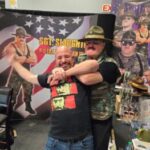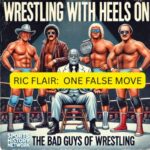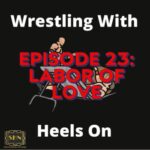The rock ‘n’ wrestling connection I want to talk about today has nothing to do with the promotional commingling of Cyndi Lauper and the WWF. As important as that union was to the resurgence of wrestling in pop culture at the start of the 80s, the rock ‘n’ wrestling connection I’m referring to has everything to do with three “musical” wrestlers and the three music icons who inspired their wrestling personas. Let’s begin this episode with the Little Richard/Johnny B. Badd connection. We’ll get to the others later.
Little Richard liked to call himself the “architect of rock ‘n’ roll” because he was singing rock ‘n’ roll in his early teens without even knowing it, thereby laying down the blueprints of the genre everybody else who followed.
Building on the foundation of Blues and Gospel artists like Muddy Waters, Ruth Brown, Mahalia Jackson, and Sonny Boy Williamson, Little Richard wrote and performed hit songs like “Tutti Frutti” and “Good Golly Miss Molly”.
Unfortunately, these songs were bigger hits when covered by singers like Pat Boone and Elvis Presley. In the 1950s, radio stations were pressured not to play black music to white audiences, feeding them milquetoast versions of the soulful originals instead.
And yet, it is a testament to Little Richard’s dynamic live performances that segregated black and white audiences often wound up partying together at the end of his concerts. His ability to bring people together through his rock ‘n’ roll showmanship and raw energy set the standard for future icons like The Beatles, The Rolling Stones, Prince, Michael Jackson, and so many more, including an up-and-coming wrestler in the 90’s named Marc Mero, better known to wrestling fans as Johnny B. Badd.
Marc Mero a.k.a Johnny B. Badd
Marc Mero has stated in interviews that Johnny B. Badd was actually created by legendary wrestler Dusty Rhodes. In addition to being an all-around great wrestler, Dusty Rhodes was also a creative force behind the scenes, writing storylines, booking matches, scouting, and mentoring young talent. One of those young talents was a jobber named Marc Mero.
Seeing Mero’s potential as a crowd draw, Rhodes rebranded Mero into a Little Richard-lookalike named Johnny B. Badd. Johnny B. Badd hailed from Macon, Georgia. This was one of many deferential nods to Little Richard, as Richard also hailed from Macon, Georgia. Sporting Little Richard’s flamboyance but no pompadour to match, Johnny B. Badd started out as a heel managed by Teddy Long, one of the few black managers during the 90s.
Playing up his heel role, Johnny B. Badd was all about tongue-in-cheek self-adulation, mixing a smidgen of Southern sass with a smidgen of Muhammad Ali, talking about “I’m so pretty, I should have been born a little girl!” Badd was a lot closer to resembling Muhammad Ali than a pretty little girl. Marc Mero was a serious former amateur boxer who’d won a few New York Golden Gloves tournaments before turning to pro wrestling. He did a lot of shadowboxing during his promos and even had a finishing move called the Tutti Frutti—a left-handed knockout hook.
With all the color and flash Johnny B. Badd brought to the ring, it was no wonder he soon became a fan favorite. Not long after he turned baby face, Johnny B. Badd added a new gimmick to his growing arsenal of Little Richard tropes: a confetti gun. While the confetti gun was probably more Rip Taylor shtick than Little Richard panache, it was still quite the crowd pleaser. The confetti gun was known as the Badd Blaster, and it was pure spectacle.
It’s too easy for anyone to dismiss Johnny B. Badd as just pure spectacle. Marc Mero was a very good wrestler.
Wildman Marc Mero
In addition to winning the WCW World Television Championship three times, Johnny B. Badd held the WWE Intercontinental Championship during his time at the WWE, where he wrestled as “Wildman” Marc Mero.
With those kinds of credentials, how could Marc Mero be anything less than a world-class wrestler? Mero trained at the Malenko Wrestling Academy in Florida, under the tutelage of the Malenko family. The Malenkos, like the Hart family of Canada and the Guerreros of Mexico, are considered wrestling royalty.
And with a physique that rivaled that of Ravishing Rick Rude, it’s a wonder Marc Mero couldn’t sustain the success he had when he was Johnny B. Badd. Let’s not forget, this man was a pure athlete in every sense of the word, playing competitive hockey as a youth, later adding boxing and bodybuilding titles to his resume.
I think it came down to one thing: Marc Mero was Johnny B. Badd, not “Wildman” Mero or any other reincarnation. How do you top the Johnny B. Badd character? How do you outdo Little Richard? There’s just nowhere else to go from there. WCW retained the rights to the Johnny B. Badd character and Mero couldn’t bring the character with him when he went to the WWE. I guess that was WCW’s way of punishing its defecting wrestlers, but it doesn’t justify the wasting of a great character. I mean, what else was WCW going to do with the Johnny B. Badd character?
As a result, Mero was forced to adopt new personas, none of which could live up to the shimmer and shine of the Johnny B. Badd character. No matter how much skill a wrestler may possess, if their character doesn’t resonate with the fans, they’re facing an uphill battle.
There’s a long rich history of flamboyant effeminate pretty-boy wrestling characters dating as far back as Gorgeous George in the 1950s. Following in George’s footsteps were wrestlers like “The Exotic” Adrian Street, “The Adorable” Adrian Adonis, “The Model” Rick Martel, Goldust, and of course, Johnny B. Badd. Their elaborate behavior, precise attention to grooming, and pageantry getting to the ring were surefire ways to piss off fans for a very long time.
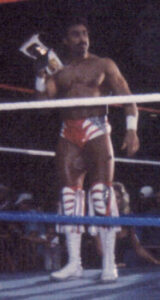
Mero Deals With Criticism
Johnny B. Badd couldn’t stay heel forever. His character was based on a beloved music icon that was still on the public’s radar when Badd came into prominence. I think wrestling fans saw Johnny B. Badd, not as a caricature but as an homage to Little Richard.
Mero, like many other wrestlers of his time, was facing a bigger uphill battle than winning over the fans with a new gimmick. He was abusing anabolic steroids and recreational drugs. Upfront about his seven years of drug abuse, and distressed by the steady rise of drug-induced tragedies in the wrestling world, Mero publicly advocated for greater regulation of the wrestling industry.
For his efforts, WWE employees criticized Mero, calling him a “silly bastard” and a “goof” who had nothing to do with the business. It was the typical knee-jerk response to whistleblowers: they’re just disgruntled employees, full of sour grapes.
Eventually, Mero left wrestling altogether and made it his mission to reach out to students in Florida schools about the consequences of drug abuse and school bullying. Anyone doubting Mero’s sincerity should check him out on YouTube during a shoot on WRESTLING SHOOT INTERVIEWS, where he talks about the origins of Johnny B. Badd, Little Richard, Dusty Rhodes, and his reasons for leaving the WCW and joining the WWE. He also talks about ex-wife Rena Mero—better known to all wrestling fans as Sable.
Mero’s joviality is infectious. There really doesn’t seem to be the slightest trace of bitterness about him. In contrast, there was a lot for Little Richard to be bitter about. He never won a Grammy and was scammed out of years and years of royalties. To boot, his white contemporaries made a lot more money than he did covering his songs.
And just to make sure no one in the music world ever forgot these indignities, Little Richard quipped (before announcing the BEST NEW ARTIST winner on the night of the 30th Grammy Award telecast): “And the Best New Artist is… Me! “I have never received nothing. Ya’ll ain’t never give me no GRAMMY.”
Little Richard’s other connection to wrestling, besides Johnny B. Badd, is singing “AMERICA THE BEAUTIFUL” at Wrestlemania 10. WWE blocked the YouTube video of his performance, but I could only presume it was a great rendition.
So what did Little Richard think about Marc Mero’s take on him?
Sitting at his piano, Little Richard pointed to a poster of Mero as Johnny B. Badd replete with androgynous pancake makeup, feather boa, matching sweatband, and relaxed black hair. Richard shook his head, ripped the photo to pieces, and said: “Uh-uh, he ain’t as pretty as me!” Marc Mero might agree with that sentiment exactly, but Johnny B. Badd however…
In the WRESTLING SHOOTS INTERVIEW segment I mentioned earlier, Marc Mero said he received a text from Little
Richard’s driver a year or two after Little Richard passed away. The driver told Mero that Little Richard liked Mero’s version of him, putting to rest any doubts Mero might have had about how the impersonation had gone over with “the architect of rock ‘n’ roll” himself. Mero seemed pleased with Little Richard’s reaction.
As Marc Mero tells it: there was Hollywood talk of a possible TV series starring Little Richard and Johnny B. Badd as a father and son team who get into all kinds of shenanigans when bad dad Richard sneaks his wild party pals into the wrestling gym owned by good son Johnny B for some after-hours hijinks. Hilarity ensues episode after episode.
I can actually see this as a syndicated show on the fall lineup of a local TV network, say New York/New Jersey’s channel 9 during the ’90s, sandwiched somewhere between “SMALL WONDER” and “SISTER/SISTER”. Good Golly Miss Molly, it would have been fun to see those two performing before a live studio audience. With those two and their flair for showmanship, I think the show would have ran for years. And it could have been called: “Keep A-Knockin’ (but You Can’t Come In)“
I know: the title’s too long.
Here’s another pitch: Johnny B. Badd vs. The Honkytonk Man. As far as I know, that never happened, but it should have. It could have. If anybody knows otherwise, please let me know.
Next time: it’s ELVIS and THE HONKYTONK MAN.
You’ve been listening to WRESTLING WITH HEELS ON.
Join me next time as we take another stroll down villainy lane….
Hi everyone. My name is Ariel Gonzalez, originally from Brooklyn, now living in the Garden State and I have a new podcast called “Wrestling With Heels On.”
On the podcast, I get to reminisce about my favorite wrestling bad guys from yesteryear. Light on stats and heavy on nostalgia, this little trip down villainy lane gives me a chance to visit the dark corridors of my wrestling soul, and it’s also fun to have a podcast.
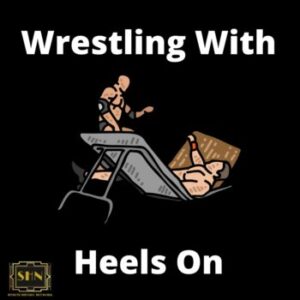
Please Note – As an Amazon Associate I earn from qualifying purchases
Resources
More Wrestling History
A Lamb to the Slaughter (WWE Superstar – Sergeant Slaughter)
There’s a reason there’s never been a mainstream movie about...
Read MoreWrestling With Andre: A Parody of My Dinner With Andre
I am a big fan of the 1981 film My...
Read MoreRic Flair’s Fake Heart Attack: The Shocking WCW Moment That Fooled Fans
A few weeks ago I found an Instagram video of...
Read MoreTAKE THIS JOB and LOVE IT!!!
INTRO (JINGLE): AMERICAN TOP 40 CASEY KASEM (IMPRESSION): You’re listening...
Read More